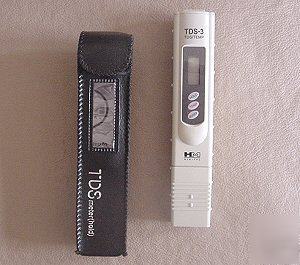|
with built-in Digital Thermometer Ideal for all water purification applications, wastewater regulation, aquaculture, hydroponics, and ionic solutions. Perfect for both consumer or commercial use. Carry one in your pocket or toolbox at all times! TDS-3 with Vinyl Carrying Case We are selling way below retail!! * Ideal for commercial use. Includes a carrying case with belt clip. * Highly efficient and accurate due to its advanced microprocessor technology. * Hold Function - Saves measurements for convenient reading and recording. * Auto-off function - Turns off meter after 10 minutes of non-use to conserve batteries. * Measurement Range: 0-9990 ppm. From 0-999 ppm, the resolution is in increments of 1ppm. From 1000 to 9990 ppm, the resolution is in increments of 10ppm, indicated by a blinking 'x10' image. * Factory Calibrated -These meters are factory calibrated with a 342 ppm NaCl solution. Meters can be recalibrated with a mini-screwdriver if re-calibration is ever needed. * Built-in digital thermometer * Comes with a protective vinyl storage/carrying case with a belt clip. * Batteries Included and installed. * TDS Range: 0 ~ 9990ppm (mg/L) * Temp. Range: 0 - 80 degrees Celsius * Resolution: 1 ppm, 1 degree Celsius (also available in 10 ppm) * ATC: Built-in sensor for Automatic Temperature Compensation of 1 to 50 degrees Celsius (33 to 122 degrees Farenheit) * Power source: 2 x 1.5V button cell batteries (included) * Battery life: over 1,000 hours of continuous use * Dimensions: 15.5 x 3.1 x 2.3cm (6.1 x 1.25 x 1 inches) * Calibration: Factory calibrated. * Weight with case: 76.5g (2.7 oz) What Are Total Dissolved Solids? Total Dissolved Solids are the total weight of all solids that are dissolved in a given volume of water, expressed in units of mg per unit volume of water (mg/L), also referred to as parts per million (PPM). 1. "Dissolved solids" refer to any minerals, salts, metals, cations or anions dissolved in water. This includes anything present in water other than the pure water (H20) molecule and suspended solids. (Suspended solids are any particles/substances that are neither dissolved nor settled in the water, such as wood pulp.) 2. In general, the total dissolved solids concentration is the sum of the cations (positively charged) and anions (negatively charged) ions in the water. 3. Parts per Million (ppm) is the weight-to-weight ratio of any ion to water. 4. Conductivity is usually about 100 times the total cations or anions expressed as equivalents. Total dissolved solids (TDS) in ppm usually ranges from 0.5 to 1.0 times the electrical conductivity. Where do Dissolved Solids come from? 1. Some dissolved solids come from organic sources such as leaves, silt, plankton, and industrial waste and sewage. Other sources come from runoff from urban areas, road salts used on street during the winter, and fertilizers and pesticides used on lawns and farms. 2. Dissolved solids also come from inorganic materials such as rocks and air that may contain calcium bicarbonate, nitrogen, iron phosphorous, sulfur, and other minerals. Many of these materials form salts, which are compounds that contain both a metal and a nonmetal. Salts usually dissolve in water forming ions. Ions are particles that have a positive or negative charge. 3. Water may also pick up metals such as lead or copper as they travel through pipes used to distribute water to consumers. Why Should You Measure the TDS level in your Water? The EPA Secondary Regulations advise a maximum contamination level(MCL) of 500mg/liter (500 parts per million (ppm)) for TDS. Numerous water supplies exceed this level. When TDS levels exceed 1000mg/L it is generally considered unfit for human consumption. A high level of TDS is an indicator of potential concerns, and warrants further investigation. Most often, high levels of TDS are caused by the presence of potassium, chlorides and sodium. These ions have little or no short-term effects, but toxic ions (lead arsenic, cadmium, nitrate and others) may also be dissolved in the water. The following are reasons why it is helpful to constantly test for TDS: High TDS results in undesirable taste which could be salty, bitter, or metallic. It could also indicate the presence of toxic minerals. The EPA's rescommended maximum of TDS in water is 500mg/L (500ppm). Test your water to make sure the filter system has a high rejection rate and know when to change your fiter(or membrane) cartridges. High TDS indicates Hard water, which causes scale buildup in pipes and valves, inhibiting performance. A constant level of minerals is necessary for aquatic life. The water in an aquarium should have the same levels of TDS and pH as the fish and reef's original habitat. TDS is the best measurement of the nutrient concentration in a hydroponic solution. TDS levels must be monitored to prevent maintenance problems. High TDS levels could impede the functions of certain applications. All of our products carry a 100% Satisfaction Guarantee! If any item is damaged or broken upon receipt, you must contact us within 3 days *This product also carries a manufacturers 3 year warranty. and $1.00 for each additional TDS3 meter. Estimated delivery time: 2-5 business days. We are not responsible for delivery times. Delivery times may vary and are only estimates. WHICH TDS TESTER IS RIGHT FOR YOU? We have been authorized Hanna Distributors for over 8 years. (this posting is the responsibility of the poster) |
s.beach@dfwind.com (Staci Beach) for more information. All emails will be forwarded to the poster's actual email address.
